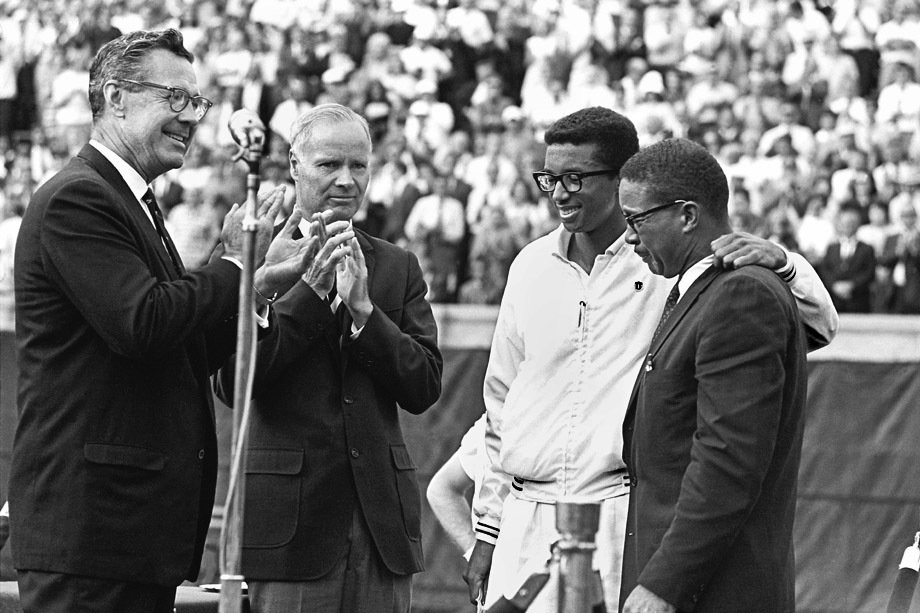When the 25-year-old Arthur Ashe was cheered as a winner at the first U.S. Open in 1968, he threw an arm around the shoulders of his fiercely proud father, who wept.
Known for his cool, cerebral public diffidence, Ashe was the first and remains, to this day, the only African-American tennis player to be men’s singles champion at the United States Open (where the stadium at Flushing Meadows is now named for him), the Australian Open (1970) or Wimbledon (1975).
Born in 1943, Arthur Robert Ashe Jr. grew up in Richmond, Va. — the old Civil War capital of Jefferson Davis’s Confederacy — in a house on the all-black Brook Field recreation ground, where his fastidious, self-effacing father (who, the son recalled, “tried to get along with everyone”) worked as a caretaker. Ashe’s mother died when he was 6.
In 1954, when the Supreme Court ruled that segregated public schools were unconstitutional, the young Ashe felt “electrified,” he later remembered, by the prospect that “we would have all the rights and opportunities that whites had.” But the court had said nothing about integrating American tennis.
At the time, Richmond was the furious engine room of “massive resistance” to federal efforts to desegregate American society. As Ashe wrote in his posthumously published memoir “Days of Grace,” he and his classmates “had to resist the worst temptation facing us: despair. If racism was so pervasive, why should we try to do our best at anything?”
Prohibited from using white tennis courts, the incensed young man was convinced that Richmond authorities were trying “to kill my game by shutting me out of any competition involving whites.” Ashe aspired to play for his country as the first African-American on its Davis Cup team, which would represent the “ultimate triumph” over those local racists. And indeed, after the University of California at Los Angeles gave him a tennis scholarship, he made it to the Davis Cup.
He won the U.S. Open the same year that black members of the U.S. Olympic team in Mexico City gave the “black power” salute. But not Arthur Ashe.
Jesse Jackson told him, “The problem with you, Arthur, is that you’re not arrogant enough.” Ashe’s tennis contemporary Billie Jean King gibed that her personality was “blacker” than his.
Ashe’s public formality was not an accident. Haunted by the vicious racial murders of Emmett Till and other young black men of the mid-20th-century South, Ashe’s anxious, protective father and other mentors had urged him to be “unfailingly polite on the court, unfalteringly calm and detached, so that whites could never accuse me of meanness.”
Ashe smarted from the fact that some African-Americans regarded him with what he called “disdain and contempt.” In his posthumous book, he later confessed feeling “a burning sense of shame” that while other blacks had shed blood in the struggle for civil rights, “I was playing tennis.”
Nevertheless, in that same memoir, he chastised black voters for “electing and re-electing demagogues and characters with dubious records, such as Marion Barry of Washington, D.C.,” and wrote, “Black power almost completely discredited the acquisition of knowledge and the rigor of self-discipline.” He added, “Our suspicion of whites and hostility to them routinely go beyond the dictates of reason.”
Ultimately this pathbreaker lived only to age 49. After suffering a serious heart attack at 36, Ashe underwent quadruple bypass surgery, then a later, corrective operation.
In 1988, during the first decade of the AIDS pandemic, Ashe was diagnosed as H.I.V.-positive, which was attributed to blood transfusions administered during his second operation. He and his wife, Jeanne, kept the diagnosis to themselves, but when a newspaper was about to break the story in 1992, Ashe himself revealed to reporters that he had contracted the illness.
“I am angry that I was put in the position of having to lie if I wanted to protect my privacy,” he told them with uncharacteristic public emotion. “I didn’t commit any crime.” When he mentioned his 5-year-old daughter, Camera, he began to cry. The following year, he died.
A poetic conclusion to this story might be that after belatedly comprehending the greatness of the late tennis champion, a penitent Richmond hastened to honor its fallen prodigy. Instead, when a statue of Ashe was proposed for the city’s Monument Avenue — already lined with five grandiose bronze statues of famous Confederates — more than a few white leaders vented their indignation, bloviating about “hallowed ground.”
Ashe got his monument, but as some of his fans still bitterly complain, it is smaller and more modest than the other ones, including one for Gen. Robert E. Lee. With his wry, quietly sardonic humor, Ashe himself might note that his statue is the only one on Monument Avenue with its back to the center of Richmond.
